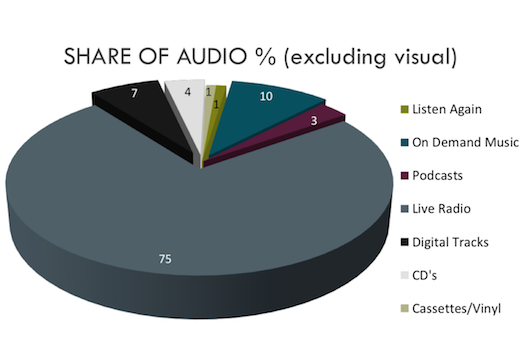Every quarter, RAJAR – the UK’s audio measurement company – releases a little piece of research called MIDAS. It probably stands for something, I don’t know; but it’s a robust piece of research that measures all kinds of interesting things.
Here’s the new MIDAS Spring 2018 study (which, for Australians reading this, means “Q1 2018”).
I get the feeling, whenever I read MIDAS studies, that they ask a whole lot more questions than they actually let us see; but here are a few interesting things that jumped out at me when I read it…
Linear Radio is not very popular on a smartphone
Out of all audio sources, “live radio” (they mean linear radio) is #3 at 21%. That’s just beaten by digital tracks (aka “my MP3 collection”) at 22%; and Spotify-like services at a whopping 39%.
I’ve argued for a while that, on a highly interactive device such as a smartphone, an entirely uninteractive thing like a linear radio stream is unlikely to hold much interest. It’s why stations like Capital (in the UK) and Kronehit (in Austria) offer a hybrid app which allows you to listen live, but to skip the bits you don’t like.
Smart speakers – very big but not very
Smart speakers, we’re told, are part of the future of radio: and that might be the case. 54% of all audio listening on them, says MIDAS, is to linear radio. So that’s great news.
Except, in total, the amount of linear radio listened-to on smart speakers is just 2.8%. The television – or the mobile phone – is almost four times more popular for listening to linear radio. Yes, radio gets its unfair share of listening on a smart speaker; but there are precious few around, and those that do exist are not replacing radios any time soon.
Radio is a social experience for younger listeners
Talk to 15-24s, and only a third are listening on their own; they’re most likely to be listening with “colleagues”, and – in comparison with all radio listeners – are three times more likely to be listening to the radio with other members of their family.
Podcasts are not a social experience at all
The most popular past-time when listening to a podcast is… simply listening to a podcast, relaxing, and “doing nothing much”. People really listen to podcasts; they’re far less of a multitasking experience than the radio is. And while 53% of people listen to the radio on their own, that figure rises to 88% of people who listen to podcasts on their own.
This points, I think, to justification why podcasts should be priced differently to radio advertising. They are, it seems, much more valuable.
Podcasts are also stable through the day
Usage reaches a high at 8.15am, but use of podcasts remains roughly constant right throughout the day until about 6.15pm; and after an evening lull, again reaches similar figures at 10.00pm (“bedtime”). It’s a fascinating difference to radio: which starts very high, reaching a peak at 8.15am; by 3.15pm radio has halved in popularity; and by 8.15pm it’s halved again.
All this data challenges us. A lot of it tells us stuff that we could have guessed anyway; more still, though, comes as a surprise.
RAJAR could keep this stuff secret, and only give it to the radio stations. It’s to their credit that they don’t; and regular as clockwork, publish it on their website. I’m unaware of any other radio research company that releases similar stuff so often. I’d urge you to take a look.
About The Author
James Cridland, the radio futurologist, is a conference speaker, writer and consultant. He runs the media information website media.info and helps organise the yearly Next Radio conference. He also publishes podnews.net, a daily briefing on podcasting and on-demand, and writes a weekly international radio trends newsletter, at james.crid.land.
Contact James at [email protected] or @jamescridland

